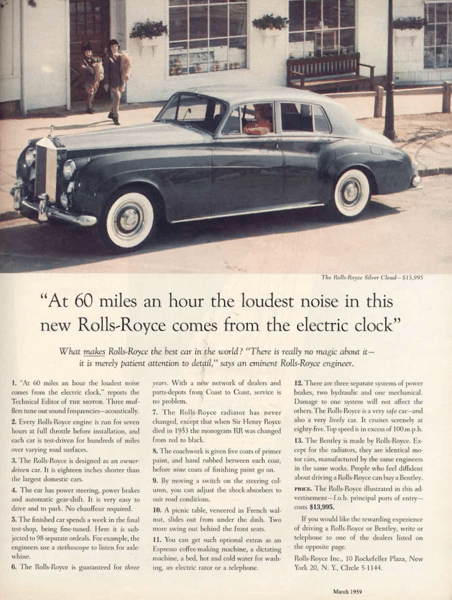

When you play Monopoly, you follow the rules. When you play "house," there are no rules to follow.
And when you’re trying to craft the perfect marketing strategy, there are essential rules to make your brand, product, and company stand out from the competition. But how do you find out what those ‘essential’ rules are?
You look to an expert in all things marketing. Which is what we did.
We’ll take you through Dave Gerhardt’s 10 timeless marketing rules that he’s learned over the course of his well-rounded career. With wide-reaching career experience, the former VP of Marketing at Drift knows a thing or two on crafting the right rules that all marketers should follow.
Though it’s true that not all methods necessarily work for every person or every company, the following 10 marketing rules lay a solid foundation for any individual or company looking to improve their overall marketing strategy, campaigns, and reach.
|
This article is part of Reach: In Retrospect. |
As marketers, you might think your ideas are the most innovative thing a potential customer will ever read, hear, or see. But as an individual, you know how exhausting it feels to be bombarded with ads, CTAs, pop-ups, and not-so-slick marketing campaigns that are really just a ploy to get your money.
So what should you do instead of inundating a potential customer or client with flashy images and hollow words? Respect their intelligence.
At G2’s first-ever conference, Reach 2019, Dave informed the audience of a very obvious thing: it’s 2019. And you know what that means? Information is free. Everywhere.
Because information is so easily accessible, your customers are going to come to your brand or company informed and full of questions. Instead of treating them like they don’t know what they want or need, assume they’ve come to you with information in tow, and be prepared to honestly answer any questions they have for you.
Remember – your buyer controls the buying process, not you.
You might wonder what Dave means by “not waiting” to start marketing, but it’s simple: if you wait to start marketing, you’ll always have an excuse as to why you can’t get started right now.
As George Washington Carver once said, 99 percent of failures come from people who have the habit of making excuses. Does that sound like you?
Now, don’t be offended. We’ve all said that we can’t get started with our marketing campaign because a product is unfinished, the design isn’t up to par, or some other excuse, but the truth is...you’re afraid. When you say you’re not ready, what you really mean is that you’re keeping secrets from the public or your competitors because you’re afraid they’ll scoop your ideas.
Guess what? They won’t.
If anything, you should be marketing before you’re ready. Dave breaks it down into three simple steps that start with a phrase you won’t soon forget: test if you should invest.
Instead of wasting your time and energy on an idea you might think is the key to growing your customer base, test it out by asking your current customers what they think, want, and need.
You don’t know what they want. But they do.
So let them tell you, and use that information to craft a product or service that your current customers will actually find value in (meaning they’ll use word-of-mouth marketing to promote it among their followers and friends). It’s a win-win all around.
Ask your followers online about project idea A or project idea B. See which one draws more interest, then use that information to help create an unbeatable solution. You already have an existing audience who believes in you and your product. Trust in them to guide you in the right direction by giving you honest feedback about your ideas.
Not all of their feedback will be positive, but you’ll need that to improve and make something worth their time and your energy.
You already know that social proof is the key to earning trust. So make sure you’re providing opportunities that allow for ratings and reviews, testimonials, and support from your contacts with a large social following of their own to give you the social proof you need to make the right marketing moves.

Dave Gerhardt speaks to the audience about social proof and why it's important.
You’ve probably heard the phrase “too many cooks in the kitchen spoil the broth” or some variant, and the same holds true with the concept of marketing by committee. Too many people (more than five, typically) going back and forth on an idea will usually lead to nothing more than miscommunication.
You might get a small group of people to agree on an idea, topic, or design for a campaign, but if you ask your entire 30-person content marketing team what article headline they like best, the chance for drastic disagreement will certainly arise.
Let's face it – it’s difficult enough for a couple to agree on where to eat for dinner – and that’s just two people. The point is, the fewer people you have involved in decision-making processes, the better.
In order for your buyers to believe in your brand, you need to prove the value of your products or services. This comes down to the phrase: show, don’t tell. You can tell a current or potential buyer all of the amazing things your brand’s product or service does, but if they can’t see a demo, try it out for themselves, or visualize the solution to their problem(s), they won’t believe you and definitely won’t trust what you’re saying.
Provide customers with an opportunity to see it so they can believe it. And once they see what your product or service can do, they’re more likely to purchase from you and tell others to, too.
In short, nobody believes case studies. Why? Well, you manufacture them. You have one of your in-house writers write up a glistening showcase of a “happy customer success story” that, while possibly true, seems like you’re buffing out any flaws and true feelings customers may have.
Not only is one of your writers making this one instance sound like the experience any and all customers will have with your brand, but they’re also making it seem like this is the one point of truth that any potential customers should look to when considering buying into your brand. And you already know, no two customers have the same background or experience with your brand or their personal needs.
Instead, Dave says you should use social proof you find “in the wild,” i.e. a third-party website where honest reviews can populate – ones you can’t alter. Third-party websites include the YouTube comments section, someone’s Twitter feed, and sites like Yelp, TripAdvisor, and G2.
No company in the world is worse than Bank of America. Literally awful. They do not protect their customers. Worst customer service. Worst everything. Actual monsters. @BankofAmerica should be ashamed of themselves. Disgusting business practices. STAY AWAY
— James Cullen Bressack (@JamesCullenB) September 14, 2019
This type of feedback is preferable for your customers because they can see what real users think about your product or service (in their own words, no less), and then make an informed decision on their own without your craftily-worded case study persuading them one way or another. And true, maybe someone’s review of your brand won’t paint you in the best light, but it’s better to be honest than to cover your blemishes with a highly manufactured case study.
If a picture’s worth a thousand words, imagine how powerful your copywriting has to be to intrigue an audience engulfed with pictures, videos, GIFs, and other bright, “loud,” colorful visuals on a regular basis. Dave notes that great copywriting is supposed to make you feel something different than other types of marketing.
Most brands try to capitalize on visual content marketing, which, while intelligently-crafted for modern audiences, relies too heavily on the visual aspect versus the written. If your copywriting sucks, it doesn’t matter how incredible your visuals are – your message is still going to fall flat.
A good example of strong copywriting, Dave notes, is this classic Rolls-Royce ad:

Instead of saying “Rolls-Royce cars are really quiet,” David Ogilvy, the copywriter, cleverly compares the quiet ticking of the electric clock within the vehicle to the sound (or lack thereof) that the car itself makes. This incredible copy makes the reader pause, think about the sound of a clock, and understand that if you’re able to hear the car’s clock ticking, imagine how whisper-soft a Rolls-Royce is on the road.
This copy engages more of the reader’s senses and intrigues them in a way that makes them want to buy a Rolls-Royce – even if they hadn’t wanted to already.
Good copywriting is selling with words, so it needs to be clear, smart, and understandable. Where the above copy is clever, it’s not too over-the-top or hard to understand. Crafty, yes. Coded? No.
In essence, your copy needs to give an emotional, thoughtful, and memorable callback to your reader. Have you ever read a billboard, banner ad, or print advertisement that stuck with you long after seeing it? That means the copy hit on all three points above.
From the beginning of time, people have shared stories. And this tactic is something smart marketers should be taking advantage of. Brand storytelling (when done right), shows people that you are a person with thoughts, feelings, and experiences, and aren’t just out to squeeze a sale out of a prospective buyer.
 Dave shows an example of using storytelling on LinkedIn to connect to his followers.
Dave shows an example of using storytelling on LinkedIn to connect to his followers.
Using social platforms to share a personal story or experience that you can tie back into your business life is one of the smartest ways to connect to your audience. But you have to know the right way to craft a story so that it can be pulled back in and used as a smart business tool.
Dave notes this storytelling framework as one to follow (and adapt as needed):
| Tell your story – X time ago, I did… |
| Pose a problem – I was faced with X issue… |
| State a solution – So I tried X thing… |
| Show examples and proof – This is how I fixed/solved X… |
| Insert your CTA/your ask – If this resounds with you, you should sign up for X… |
One of the best storytelling platforms where you can capitalize on business leads is LinkedIn. With the ability to write short-form statuses (up to roughly 1250 characters) or long-form articles in a blog post style, you’ll be able to reach an audience within your connections network and beyond.
Instead of trying to cover missteps, mistakes, and errors with crafty marketing techniques, show your customers that you are real by breaking down the walls of your typical marketing campaign.
The easiest ways to do this are by showing that you are human, make mistakes, and are actively seeking a way to solve any existing problems. Addressing your flaws up front instead of covering them up with help build brand authenticity and trust. Don’t try to falsify data, information, or reviews to paint your brand in a good light; be honest and tell your customers where you’re lacking and how you’re trying to be better for them.
An example of authentic branding is Pepsi’s Super Bowl “Is Pepsi okay?” advertisement. Everyone knows that if you go out to eat and ask for a Coca-Cola, depending on the restaurant, they might only serve Pepsi products, prompting them to ask you if Pepsi’s okay. So, instead of letting this somewhat demeaning catchphrase bog them down, Pepsi decided to turn it into an awesome marketing campaign chock full of celebrities.
Using this authentic marketing tactic spun a negative into a positive that ultimately benefited Pepsi’s brand in the long run.
Drift used this same tactic by crafting an article titled “4 Reasons Customers Quit Drift in 2017,” which called their own brand out for the top reasons people were quitting their brand. Instead of angrily targeting customers or saying the reasons they left were invalid, they highlighted customer pain points and concerns by showing future/potential customers how they were remedying the issues straight away.
People want to work with a brand that shares their values. Whether it’s a social, business, or political value, making a statement of belief that comes directly from your brand shows that you have a belief system or set of beliefs by which the brand at large adheres to, even if individuals who work for the brand may have differing personal views.
You might be worried about alienating a group of people by making a stand that speaks boldly about a certain point of view, but in the end, it’s important to showcase a general belief on points of concern for your customers. If it’s something that keeps certain people from buying in, but welcomes others to your brand by knowing they can believe in you, what’s best for the majority is best for you.
This might be the simplest rule on the list. If you’re doing the same things as your competitors, there’s absolutely no way for you to stand out. So, do something different. As Dave says, zig when everyone else zags. That doesn’t necessarily mean take a risk that could put you at a disadvantage, but it does mean doing something risky that puts your brand on the map.
Dave notes how Drift was at SaaStr and used a branded van to take people from point A to point B. What did this do to benefit Drift? Well, other than providing above and beyond service to anyone – they got their name out in a clever and unique way. And then? They made a quick recap vlog about Drift’s experience at SaaStr, full of footage of their Drift van riding around picking people up and dropping them off.

If you successfully do eight of the 10 things listed above, you’re going to build a strong brand, and your marketing team will have all of the tools they need to succeed. If you notice you’re lacking in one or more of the above areas, you can take steps toward improving your approach to marketing best practices.
In all, your customers and potential customers’ wants and needs should be your main focus. Building a trustworthy brand that does its best to address customer concerns in a timely, honest manner is one of the top ways to build trust among consumers, and certainly the best way to get your name out there.
Being proactive rather than reactive will boost your credibility, success, and overall customer happiness.
Rebecca Reynoso is the former Sr. Editor and Guest Post Program Manager at G2. She holds two degrees in English, a BA from the University of Illinois-Chicago and an MA from DePaul University. Prior to working in tech, Rebecca taught English composition at a few colleges and universities in Chicago. Outside of G2, Rebecca freelance edits sales blogs and writes tech content. She has been editing professionally since 2013 and is a member of the American Copy Editors Society (ACES).
Every successful content strategy starts with data.
 by Marta Szyndlar
by Marta Szyndlar
An inbound marketing strategy is holistic, data-driven, and aims to attract the right...
 by Jen Spencer
by Jen Spencer
It’s almost here. We’ve nearly reached the 2020s, a decade that once sounded positively...
 by Julia McCoy
by Julia McCoy
Every successful content strategy starts with data.
 by Marta Szyndlar
by Marta Szyndlar
An inbound marketing strategy is holistic, data-driven, and aims to attract the right...
 by Jen Spencer
by Jen Spencer
Never miss a post.
Subscribe to keep your fingers on the tech pulse.



